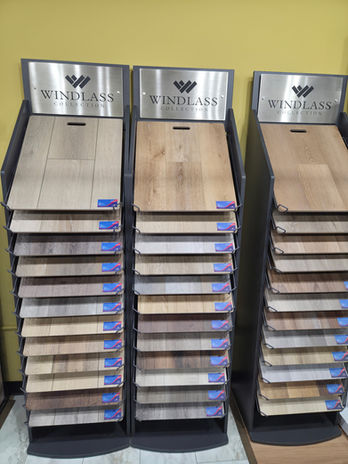Vinyl
Explore Your Vinyl Flooring Options
Vinyl is a popular and growing category in the flooring market, known for its water resistance, affordability, and wide variety of hard surface styles. From realistic wood and stone looks to modern textures and finishes, vinyl offers options for every space and budget. Understanding the different types of vinyl flooring can help you make the best choice for your home or business.
Check Out Our Variety of Vinyl
Sheet Vinyl
Sheet vinyl is available in large rolls, cut to fit your space for a smooth, nearly seamless finish. Known for its durability and water resistance, it's an excellent choice for kitchens, bathrooms, and other moisture-prone areas. With roll widths of 12 or 13'2", many rooms can be covered with little to no seams—making it one of the most water-resistant flooring options available.
While sheet vinyl is a durable and affordable flooring option, it's important to be aware of a few limitations. It can be prone to dents or tears from heavy furniture or sharp objects. If moisture gets underneath, it may cause stains to appear from below. Additionally, because sheet vinyl is thin, it can sometimes reveal imperfections in the subfloor beneath.

Glue-Down Plank
Glue-down vinyl planks are installed piece by piece, adhered directly to the subfloor for a stable, long-lasting fit. Unlike floating floors, this method creates a more permanent solution that's ideal for high-traffic areas and commercial environments, especially those with rolling loads or continuous foot traffic.
These planks are valued for their durability, but they can scratch and may reveal imperfections from the subfloor below. One of the key advantages—especially when using pressure-sensitive adhesive—is the ability to easily replace individual planks if damaged, without removing the entire floor.
However, depending on factors like temperature changes, adhesive type, and heavy loads, minor lifting at the seams can occur and is a normal drawback from this type of flooring.

LVP/LVT (Luxury Vinyl Plank/Luxury Vinyl Tile)
Floating vinyl planks, or LVP, are designed to click together and "float" over the subfloor without the need for glue or nails. These planks offer a high-end, realistic wood look and are popular for their ease of installation—making them a great option for residential use and DIY projects. They can be installed over a wide range of subfloors, as long as the surface is flat and solid.
That said, no subfloor is perfectly level—especially in older homes or those with structural movement—which can eventually impact the locking system. And while LVP is often marketed as waterproof, moisture from below can still lead to warping or shifting, potentially weakening the floor’s integrity over time. Because of these factors, LVP may have a more limited lifespan compared to other installation methods.

Laminate Flooring
Laminate flooring is a cost-effective, floating floor option that clicks together for easy installation, similar to luxury vinyl plank (LVP). It’s typically a bit thicker than LVP, offering a more stable and solid feel underfoot at the same price point. Laminate features a high-density fiberboard core topped with a durable, realistic image layer and a tough wear layer—providing a convincing wood look and excellent resistance to everyday wear and tear. It’s highly scratch resistant (though not scratch-proof), making it a solid choice for high-traffic areas in residential spaces.
However, despite many laminate products being marketed as water-resistant, this protection is usually only topical. If water seeps between seams or sits too long, it can be absorbed by the core, causing it to swell or warp. This makes laminate less suitable for areas prone to moisture, like bathrooms or basements. While it's a strong and stylish flooring option, proper installation and care are key to ensuring its longevity.
.jpg)
Completed Vinyl Projects










